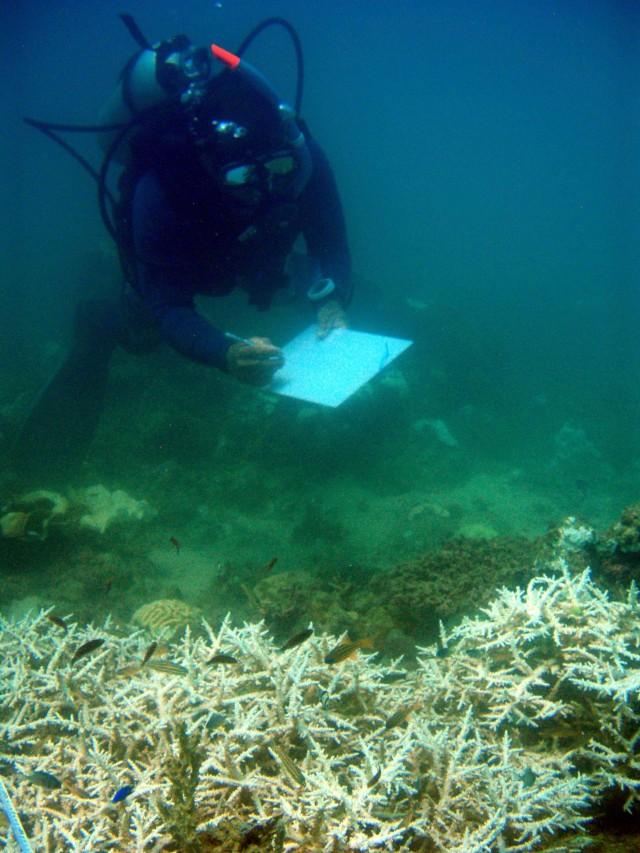Pinoy scientists urge public to rescue coral reefs through social media
 Corals off Pescador Island, Cebu, bleached during the 2010 mass bleaching event. Scientists need reports from the field to see how coral reefs are reacting to the 2016 sustained ocean warming due to El Niño. Massimo Mazzitelli
Corals off Pescador Island, Cebu, bleached during the 2010 mass bleaching event. Scientists need reports from the field to see how coral reefs are reacting to the 2016 sustained ocean warming due to El Niño. Massimo MazzitelliNow almost anyone can do their part to help protect the Philippines' rich but fragile marine ecosystem.
The Philippine Coral Bleaching Watch, an online reporting platform for coral bleaching in the Philippines, was relaunched by the University of the Philippines Marine Science Institute last May 17.
First established by UP MSI to document the 2010 mass coral bleaching event, the PCBW website and social media platforms aim to encourage Filipinos to put their head in the water and be involved in updating scientists, NGOs, and national government on the status of coral reefs in their areas.
The scientists are asking everyone—whether you're a casual swimmer or a hardcore diver—to report any sightings of bleached coral by visiting the PCBW online form or via their Facebook page.
Click here to report a sighting to PCBW.
Click here to visit the PCBW Facebook page.
Reports can be submitted thorough the PCBW reporting form above. The PCBW Facebook page also posts additional information on coral bleaching, which sites are currently under a bleaching watch, and what people can do to reduce the stress on already perturbed reefs.
 Scientists are relying on Filipino citizens to help them monitor the country’s coral reefs by submitting photos of bleaching or non-bleaching corals from their areas. Miledel Quibilan
Scientists are relying on Filipino citizens to help them monitor the country’s coral reefs by submitting photos of bleaching or non-bleaching corals from their areas. Miledel QuibilanDespite providing trillions of pesos worth of goods and services, such as food (by serving as habitat for fish and other animals), protection from storm surges, buffering coastal erosion, source of natural products for biomedical uses, and jobs through recreation and tourism, only 5% of all Philippine coral reefs are in excellent condition.
Coral reefs worldwide are threatened by human-induced climate change, sedimentation, pollution, coastal development, destructive fishing practices, and irresponsible tourism.
"The Philippine Coral Bleaching Watch was established because we need to know the extent and severity of the coral bleaching impact on coral reefs and engage with the concerned stakeholders to provide timely responses", said Dr. Porfirio Aliño, National Academician and one of the Philippines’ leading coral scientists.
“Engaging with an informed citizenry, scientists, together with coastal communities, can be engaged in monitoring the entire Philippines. So we are relying on bridging science to responsible citizens to submit reports of bleaching or assessment reports through photos of panoramic views of healthy reefs in their areas."
Coral reefs are the result of the partnership between the host coral animal colony and its zooxanthellae algae. The algae gives the coral its extra sugars from photosynthesis, while the coral gives the algae its waste phosphates and nitrates (AKA coral poop). This partnership allows coral reefs to thrive in clear, nutrient-poor water.
However, when corals are subject to stresses like consistently unusually (e.g. +2o C) high water temperature and strong sunlight, this partnership breaks down and the coral ejects the algae from its body. As it is the algae that gives the coral its brown color, the coral now appears white (or "bleached") because the coral's white calcium carbonate skeleton can now be seen. Bleached corals are still alive but are more vulnerable to starvation and other stresses. — TJD, GMA News




